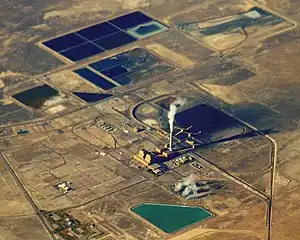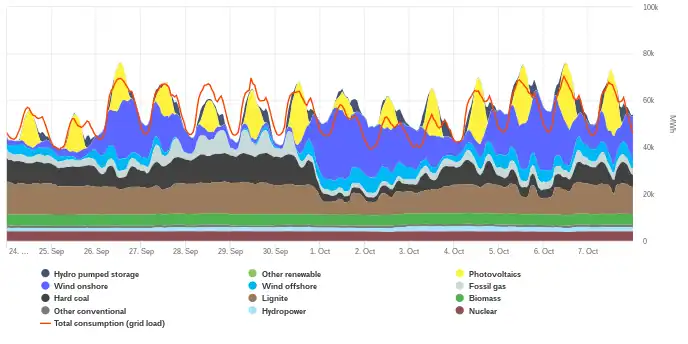
A Combined cycle hydrogen power plant is a power plant that uses hydrogen in a combined cycle power plant. A green hydrogen combined cycle power plant is only about 40% efficient, after electrolysis and reburning for electricity, and is a viable option for energy storage for longer term compared to battery storage. Natural gas power plants could be converted to hydrogen power plants with minimal renovation or do a combined mix of natural gas and hydrogen.[2][3]
Retrofitting natural gas power plants
Natural gas power plants could be designed with a transition to hydrogen in mind by having wider inlet pipes to the burner to increase flow rates because hydrogen is less dense than natural gas, and have the right material because hydrogen can cause hydrogen embrittlement.
Limitations
Current electrolysis plants are not capable of providing the scale of hydrogen that is needed to provide for a large scale power plant. On site electrolysis may be needed, then storing large amounts of hydrogen could take up a lot of space if it is only compressed hydrogen and not Liquid hydrogen. Hydrogen embrittlement could happen in pipelines, but 316L stainless steel pipelines could handle compressed hydrogen above 50 Bar (unit), which is what compressed natural gas is piped at, or wider pipelines could be built for hydrogen. Polyethylene or fiber-reinforced polymer pipelines coule also be used.
Nitrous oxide
When hydrogen is burned as a fuel no carbon dioxide is produced, but more nitrous oxide is produced because of the higher flame temperature from hydrogen, a selective catalytic reduction process could be implemented to break NO₂ down into just nitrogen and water. The exhaust from a burning hydrogen reaction is water vapor and could be used as a diluent to lower the high burning temp that creates the nitrous oxide.
Corrosion
Corrosion of the turbine from the water vapor from the hydrogen flame could reduce plant life or parts may need to be replaced more often.
Fuel handling
Hydrogen is the smallest and lightest element and can leak more easily at connection points and joints. Hydrogen diffuses quickly mitigating explosions. A hydrogen flame is also not as visible as a standard flame.
Transition to a renewable power grid
Wind and solar power are variable renewable energy sources that aren't as consistent as base load energy. Hydrogen could help renewables by capturing excess energy, with electrolysis, when they produce too much, and fill the gaps with that energy when they aren't producing as much.
See also
References
- ↑ Puko, Timothy (1 May 2023). "This power plant offers a peek into the future". The Washington Post. Retrieved 5 October 2023.
- ↑ Mulder, Sebastiaan (29 October 2021). "Ready for the Energy Transition: Hydrogen Considerations for Combined Cycle Power Plants". POWER Magazine. Retrieved 5 October 2023.
- ↑ Leigh Collins (29 July 2021). "Why hydrogen-fired power plants 'will play a major role in the energy transition'". Recharge. Retrieved 5 October 2023.
- ↑ "Flexible Power Plant Operation to Enable High Renewable Energy Penetration". IESR. 15 June 2022. Retrieved 21 November 2022.
